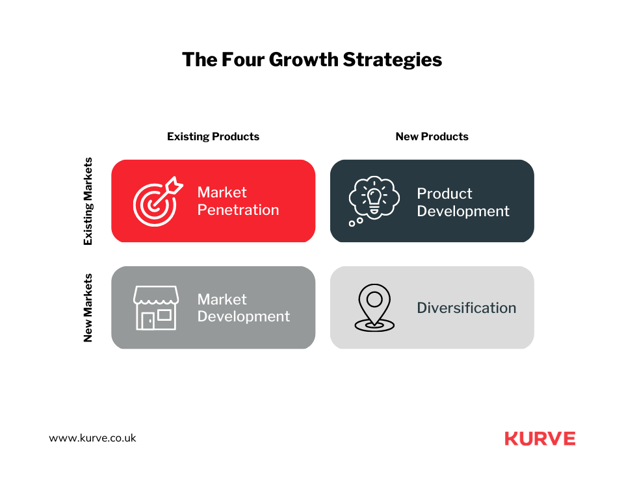Growing a business is no walk in the park. With statistics showing a high failure rate among startups within their first decade, a robust growth strategy is non-negotiable. This detailed guide delves deep into what a growth strategy is, why it’s essential, and the steps to create one that yields sustainable growth.
Understanding Growth Strategies: The Roadmap to Business Expansion
Imagine a business without a clear direction; it’s like a ship sailing without a compass. A growth strategy is that compass, providing a clear roadmap for increasing a business’s size, revenue, and overall value. It’s about gaining a competitive edge and identifying the most efficient path to achieve sustainable success.
A well-defined growth strategy goes beyond merely outlining goals; it involves:
In-depth Diagnosis: Analyzing the market landscape, studying competitors, and understanding your current position through metrics and benchmarks. This includes comprehensive market research to understand customer behavior and preferences.
Guiding Policy: Establishing a clear direction and communicating it effectively across the organization. This involves setting realistic milestones and outlining the actions needed to achieve them.
Actionable Steps: Detailing the specific tactics, operational processes, and governance structures to implement the strategy effectively.
By considering these three elements, businesses can create a comprehensive growth strategy that is both practical and results-oriented.
Who Needs a Growth Strategy?
Whether you’re a budding startup or an established enterprise, a growth strategy is essential for every business aiming for long-term success. It helps you navigate market competition, overcome financial hurdles, and adapt to ever-changing customer demands.
Decoding the Ansoff Matrix: Four Strategies for Business Growth
While several frameworks guide growth strategy development, the Ansoff Matrix remains one of the most widely used and effective. It helps businesses analyze their current market position and explore new opportunities for growth.
 The four growth strategies
The four growth strategies
The Ansoff Matrix utilizes two key axes: products and markets. This matrix helps to identify potential strategies by considering whether to focus on existing products/markets or explore new ones.
Let’s dive deeper into each quadrant of the Ansoff Matrix:
1. Market Penetration: Deepening Your Roots
Market penetration involves expanding the sales of existing products within existing markets. Think of it as squeezing every drop of opportunity from your current offerings and customer base.
Tactics for effective market penetration include:
- Competitive Pricing: Attracting customers with competitive pricing strategies or bundle deals.
- Enhanced Customer Engagement: Focusing on customer retention through loyalty programs and personalized experiences.
- Content Marketing: Creating valuable content that resonates with your target audience and drives conversions.
2. Market Development: Exploring New Horizons
Market development focuses on introducing existing products to new markets. This could involve targeting a new customer segment or expanding geographically.
Key considerations for successful market development:
- Thorough Market Research: Identifying new market segments that align with your product offerings.
- Targeted Marketing Campaigns: Crafting messaging that resonates with the specific needs and preferences of your new target audience.
- Strategic Partnerships: Collaborating with businesses that cater to your new target market to leverage their existing customer base.
3. Product Development: Innovating for Growth
Product development is all about creating new products to cater to your existing market. It’s about innovating and staying ahead of the curve to meet evolving customer demands.
Effective product development strategies include:
- Customer Feedback Analysis: Understanding customer needs and pain points to identify opportunities for product improvement or new product development.
- Trend Monitoring: Staying informed about industry trends and technological advancements to develop products that are relevant and desirable.
- Agile Development: Employing agile methodologies to ensure flexibility and speed in bringing new products to market.
4. Diversification: High Risk, High Reward
Diversification is considered the riskiest growth strategy, as it involves introducing new products to entirely new markets. However, it also presents the potential for significant rewards if executed successfully.
Navigating the challenges of diversification:
- Comprehensive Market Analysis: Conducting in-depth research to understand the new market landscape, including customer behavior, competition, and regulatory environment.
- Resource Allocation: Ensuring sufficient financial and human resources are allocated to support the development and launch of new products in a new market.
- Risk Mitigation: Implementing strategies to minimize potential losses and adapt quickly to unforeseen challenges.
Connecting the Dots: Aligning Your Growth Strategy with Marketing Efforts
A successful growth strategy is not confined to a document; it needs to be interwoven with your marketing efforts to drive tangible results. Here’s how you can align your growth strategy with your marketing:
1. Defining Your Unique Value Proposition (UVP)
Your UVP is what sets you apart from competitors. It’s the unique blend of benefits you offer to your target audience. Define your UVP clearly and communicate it effectively through your marketing messages.
2. Understanding Your Customer Journey
Map out the different stages your customers go through, from becoming aware of your brand to making a purchase. This understanding will enable you to tailor your marketing messages and touchpoints to effectively guide them through the sales funnel.
3. Leveraging the Right Marketing Channels
Not all marketing channels are created equal. Identify the platforms where your target audience spends their time and tailor your marketing efforts accordingly. This could involve a mix of online and offline channels, such as social media marketing, content marketing, email marketing, events, and more.
4. Data-Driven Decision-Making
In today’s digital landscape, data is king. Track your marketing metrics diligently and use the insights derived to make informed decisions about your growth strategy. Tools like Google Analytics can provide valuable data on website traffic, user behavior, and campaign performance.
Crafting Your Growth Strategy: A Step-by-Step Guide
Now that we’ve covered the essential elements of a growth strategy, let’s outline a practical framework for creating one for your business:
1. Define Your Business Goals
Start by clearly defining what you want to achieve with your growth strategy. Are you aiming for increased revenue, market share expansion, new customer acquisition, or a combination of these? Setting clear goals provides direction and allows you to measure success effectively.
2. Conduct Thorough Market Research
Understanding your target market is paramount. Dive deep into their demographics, psychographics, needs, pain points, and preferences. Analyze your competitors to identify their strengths, weaknesses, and market positioning.
3. Brainstorm Growth Ideas
Gather your team and conduct brainstorming sessions to generate innovative growth ideas. Encourage open communication and explore all potential avenues for growth, no matter how unconventional they may seem.
4. Prioritize and Select Growth Strategies
Evaluate the feasibility of each growth idea based on factors such as market potential, resource availability, and alignment with your overall business goals. Prioritize the strategies that offer the highest potential for success with manageable risk.
5. Set Measurable KPIs
Key Performance Indicators (KPIs) are crucial for tracking the effectiveness of your growth strategies. Identify specific, measurable, achievable, relevant, and time-bound (SMART) KPIs to monitor your progress and make data-driven adjustments along the way.
6. Implement and Iterate
Once you have a solid plan, it’s time to put your growth strategies into action. Remember that growth is an iterative process. Continuously monitor your progress, gather data, analyze results, and be prepared to make adjustments based on your findings.
7. Scale What Works
As you implement your growth strategies, you’ll likely identify tactics that are more effective than others. Double down on those winning strategies and allocate more resources to maximize their impact.
Choosing the Right Growth Strategy: A Tailored Approach
The best growth strategy for your business will depend on several factors, including your industry, target market, resources, and risk appetite. There is no one-size-fits-all solution.
Consider these key factors when selecting your growth strategy:
- Market Size and Potential: Evaluate the size and growth potential of your target market to determine if it aligns with your growth ambitions.
- Competitive Landscape: Analyze the competitive landscape to identify opportunities for differentiation and market penetration.
- Resource Availability: Assess your financial resources, human capital, and technological infrastructure to ensure you can effectively implement your chosen growth strategy.
- Risk Tolerance: Determine your appetite for risk and choose a growth strategy that aligns with your comfort level.
Conclusion: Embracing Continuous Growth
Building a successful business is a marathon, not a sprint. By embracing continuous growth as a core principle and implementing a well-defined growth strategy, you can navigate the ever-changing business landscape and position your company for long-term success. Remember to stay agile, adapt to market dynamics, and prioritize data-driven decision-making to fuel your growth journey.



